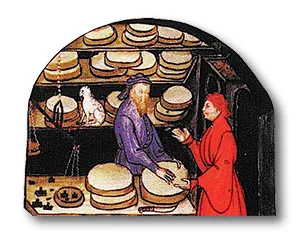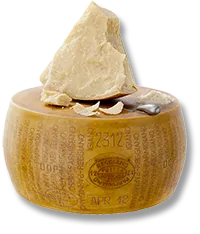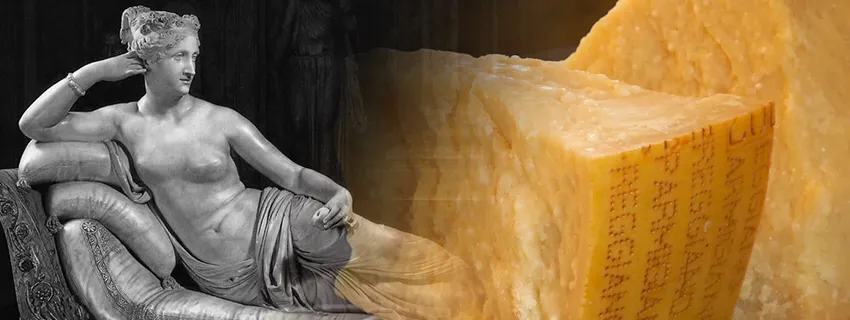Published:
Author: Antonio Maria Guerra
Parmigiano
The Original Parmesan
HISTORY, INFO, PLACES, INTERESTING FACTS

It’s not possible to understand the value of Parmigiano Reggiano, the original Parmesan cheese, without knowing its history, which spans more than 900 years, its places and its top quality ingredients. Let’s deepen the knowledge of this excellence with the precious help of the Consortium of its more traditional producers.

What is Parmigiano Reggiano?
Parmigiano Reggiano, also known outside Italy as ‘Parmesan’, is a ‘hard paste’ cheese, characterized by low water content and an aging period that can vary from a minimum of 12 months to well over 30. This specialty is produced in the provinces of the Italian cities of Parma, Reggio Emilia, Modena, Mantua (on the right of the Po river) and Bologna (on the left of the Reno river). It’s the fruit of a very ancient tradition, begun in the Middle Ages by Benedictine and Cistercian monks. Both the quality of its ingredients and the way it’s prepared have remained unchanged over time: not surprisingly, Parmigiano Reggiano has been awarded the PDO Denomination, whose main purpose is to protect its unique features.
In this article we’ll show you the production method currently used for Parmigiano Reggiano, the original Parmesan cheese. To read it, please click this LINK.


The history of Parmigiano Reggiano.
 The origins of Parmigiano Reggiano date back, more or less, to the 12th Century, that is to say to the Middle Ages. According to some sources, they could be even older.
The origins of Parmigiano Reggiano date back, more or less, to the 12th Century, that is to say to the Middle Ages. According to some sources, they could be even older.
The first makers of this cheese were the Benedictines and Cistercians monks of the monasteries located in the plains around the cities of Parma and Reggio Emilia. Thanks to the excellent milk produced in the local pastures and to the salt coming from the famous salt pans of Salsomaggiore, these monks gave life to a type of food both appetizing and nutritious that, at the same time, could be preserved: this was a very precious feature, especially at that time.
It should therefore not surprise the great success that this specialty immediately achieved: the ‘caseus parmensis’ (first name of Parmigiano Reggiano), thanks to its relative ease of transport, quite soon began to be sold all around Italy (*1) and, gradually, in the rest of Europe.
Read more
 Over the years, the monks lost their exclusivity in the production of this cheese, being initially emulated by rich aristocratic families, then by simple citizens with a strong artisan vocation (*3). There are many proofs of the great success of the ‘Parma cheese’ on the tables of the Renaissance banquets. It’s, therefore, no coincidence that in 1612, for the first time, the main features of this specialty were certified in a document (*4) strongly supported by the Duke Ranuccio I Farnese, who was determined to protect one of the leading products of his land.
Over the years, the monks lost their exclusivity in the production of this cheese, being initially emulated by rich aristocratic families, then by simple citizens with a strong artisan vocation (*3). There are many proofs of the great success of the ‘Parma cheese’ on the tables of the Renaissance banquets. It’s, therefore, no coincidence that in 1612, for the first time, the main features of this specialty were certified in a document (*4) strongly supported by the Duke Ranuccio I Farnese, who was determined to protect one of the leading products of his land.
This cheese is synonymous with tradition: suffice to say that its preparation method has remained unchanged for centuries, with the sole exception of the use of whey and steam heating at the beginning of the 1900s
The desire for protection triggered by the Duke of Parma gradually grew to culminate in the foundation, in 1954, of the ‘Consorzio del Parmigiano Reggiano’.
Notes:
*1: As proven by a Genoese notarial deed dating back to 1254;
*2: Many documents show its presence in Germany, France, Spain and Flanders;
*3: This passage culminated in the Napoleonic era with the abolition of ecclesiastical possessions;
*4: Considering its content, it’s the true ancestor of the modern product specification document;

Parmigiano Reggiano
THE MOST TRADITIONAL PRODUCERS
This article is the result of the collaboration between WebFoodCulture and the Consorzio del Formaggio Parmigiano Reggiano, organization gathering the most traditional producers of the famous specialty.
The production areas.
Parmigiano Reggiano is produced in the Italian Region of Emilia-Romagna, in an area including the provinces of Parma, Reggio Emilia, Modena
Read more
and part of the provinces of Bologna (to the left of the river Reno) and Mantua (to the right of the river Po).

Parmigiano or Parmesan?
 Parmigiano Reggiano is one of the most famous and appreciated cheeses in the world since the Middle Ages. Such a tradition makes this product unique and inimitable, adding some very peculiar characteristics: these derive, for example, from the historical skill of its makers and the quality of its ingredients. Factors indissolubly binding this specialty to its territory.
Parmigiano Reggiano is one of the most famous and appreciated cheeses in the world since the Middle Ages. Such a tradition makes this product unique and inimitable, adding some very peculiar characteristics: these derive, for example, from the historical skill of its makers and the quality of its ingredients. Factors indissolubly binding this specialty to its territory.
Outside Europe, Parmigiano Reggiano is often known as ‘Parmesan’: in many states this name often indicates also products that sometimes are just ‘inspired’ to the original. Although some of these cheeses may be of good quality, they’re inevitably different, starting with the taste. Moreover, as it’s easy to understand by reading this article, they don’t and will never have the traits of a specialty that, not surprisingly, is considered by many the ‘King of Cheeses’.
Exploiting the ambiguity of the name ‘Parmesan’ to lure unaware consumers is a smart expedient that certainly pays off, but is irremediably destined to fail at the first bite of the real Parmigiano.

Verdi’s music.
Giuseppe Verdi’s music is most probably the ideal choice to accompany some Parmigiano Reggiano. About this, it’s important to remember that the famous Italian composer was originally from Busseto, a small town not far from the city of Parma.

Parmigiano: pairings.
Parmigiano Reggiano can be tasted alone or paired with other foods. The most successful pairings depend much on the age of the cheese.
When it’s ‘fresh’ (12/18 months), it can be accompanied by:
- Salads and fresh vegetables;
- Fresh fruit: pears, apples, strawberries, grapes;
Read more
When it’s more aged (over 24/30 months), it can be accompanied by:
- Dried fruits: walnuts, hazelnuts, dried figs;
- Jams, mustards and honey;
- Balsamic vinegar;
When grated, it’s perfect for seasoning pasta dishes, risottos and soups. It is also an excellent ingredient in the preparation of savory pies.

Pairings.
Choosing the right wine to pair with Parmigiano Reggiano depends much on the aging of the cheese:
- ‘Fresh’ Parmigiano (min. 12 months): this can be accompanied by a dry white wine, with good acidity, such as ‘Vernaccia di San Gimignano’, or a bottle-fermented sparkling wine, such as ‘Franciacorta’, ‘Trento Classico’ or ‘Champagne’;
Read more
- Medium-aged Parmigiano (24 months and more): this can be accompanied by a medium-bodied red wine, such as ‘Chianti Classico’ or a ‘Bardolino’;
- Aged Parmigiano (approx. 30/36 months): this can be accompanied by a structured red wine, such as a ‘Barolo’, ‘Barbera d’Asti’ or ‘Amarone’.

The origins of the name.
Parmigiano Reggiano, one of the most famous cheeses in the world, has not always had this name: during the Middle Ages, this specialty was generically known as ‘caseus parmensis’ (Latin for ‘cheese from Parma’). One of the first written testimonies about the use of the word ‘Parmigiano’ dates back to 1344 and can be found is in the novella ‘Calandrino e elitropia’, part of Giovanni Boccaccio’s Decameron.
Read more
1612 was a particularly important year for this cheese, since the Duke of Parma Ranuccio I Farnese, to protect the most exported product of his lands, had a special notarial document to certify the name ‘Parmigiano’ and the place of origin of the specialty (*1).
The name ‘Parmigiano Reggiano’ started to be used only in 1938.

Parmigiano from the Italian mountains.
Some wheels of Parmigiano Reggiano differ from the others for the presence of a plaque bearing the words ‘Prodotto di Montagna’ (‘Mountain Product’): this indicates that the cheese has particular organoleptic characteristics, mainly due to its place of origin.
Read more
Parmigiano Reggiano ‘Prodotto di Montagna’, although it’s made by companies belonging to the Consortium, must necessarily comply with some additional rules than those contained in the ‘regular’ product specification document. These require, for example, that the breeding of cows and the production phases (including maturing) take place in mountain areas.

Nutritional values.
Parmigiano Reggiano contains 30% water and 70% nutrients: among these, the most useful for health are proteins (A, B2 and B6), calcium and phosphorus. The presence of fat is not excessive, but attention must be paid to sodium. Lactose and carbohydrates are almost completely absent. This cheese has no additives.

The aphrodisiac properties of Parmigiano.
Although there is no scientific evidence for this, Parmigiano Reggiano is often considered a type of food with aphrodisiac properties. A possible explanation for this probably lies in the presence in this cheese of a particular type of amino acid indirectly linked to sexual desire.
Read more
In addition, it contains a large number of nutrients that can actually increase physical performance. No coincidence that this specialty is often part of athletes’ diet.

Parmigiano in the Decameron.
The oldest written evidence about Parmigiano and its great fame throughout history can be found in Giovanni Boccaccio’s Decameron, a book written between 1350 and 1353. This cheese is mentioned in the novella ‘Calandrino and elitropia’, in which the author, to describe the fabulous country of ‘Bengodi’, writes:
Read more
“… a mountain, made with grated Parmesan cheese’, on which dwell folk that does nothing else but make macaroni and ravioli, and boil them in capon’s broth, and then throws them down to be scrambled for.”t eravi una montagna tutta di formaggio Parmigiano grattugiato, sopra la quale stavan genti, che niuna altra cosa facevan, che fare maccheroni e ravioli e cuocerli in brodo di capponi, e poi li gittavan quindi giù, e chi più ne pigliava, più se n’aveva”
This paragraph is very interesting, not only because clarifies that Parmigiano at that time was already considered a delicacy fit for a king, but also because indicates that it was grated and used to season pasta.

Parmigiano: the cheese loved by celebrities.
Parmigiano cheese has always been very popular. Many people have deeply loved its taste, among them a great number of celebrities. For example:
- Moliere (1622-1673): it is said that the French playwright appreciated Parmigiano so much to desire to savor it before dying;
Read more
- Casanova (1725-1798): according to his memoirs, the great Italian lover often gave to his women Parmigiano cheese instead of flowers;
- Napoleon (1769-1921 ): the Emperor of the French started to love Parmigiano cheese thanks to his wife Maria Luigia, Duchess of Parma;
- Dumas (1802-1870): the author of the Three Musketeers loved cooking and often offered to his friends macaroni seasoned with Parmesan;

Consorzio del Parmigiano Reggiano: contacts.
Address: Via John Fitzgerald Kennedy, 18
42124 Reggio Emilia (RE)
Website: www.parmigianoreggiano.it
Mail: staff@parmigianoreggiano.it
Tel.: +39 0522 307741
Copyright information.
The images displayed in this page belong to WebFoodCulture and to the Consorzio del Formaggio Parmigiano Reggiano, with the exception of:
Public Domain images
- G.Verdi, ritratto, 1886, G.Boldini (Wikipedia Link) {PD-Art} {PD-US}
- Boccaccio, manoscritto (Wikipedia Link) {PD-Art} {PD-US}
Creative Commons images
- Paolina Borghese, Canova, immagine appartenente a Art Gallery ErgsArt (Wikipedia Link)

